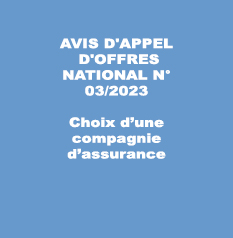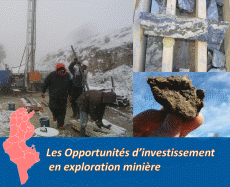| Programme annuel & rapport de suivi technique |
-

Rapport d'activités 2023
-

Programmes Techniques 2024
|
| Géocatalogue |

|
| Appels d'Offres |
-

ACQUISITION DES TICKETS RESTAURANT POUR LE PERSONNEL DE L’ONM
-

CHOIX D’UNE COMPAGNIE D’ASSURANCE
-

ACQUISITION ET MISE EN ŒUVRE D’UN PROGICIEL DE GESTION INTEGRE
|
|
Investir en Tunisie |


|
|
|
|
|
::
Documentation and Editions
>>
Research library
|
| |
|
[
Search by author
]
[
Search keyword
]
[
Search by index
]
[
Search by category
]
|
title of the reference :
|
Diapir and Zn-Pb mineralization
|
|
Publication Date:
|
1996
|
|
Author :
|
Sheppard S.M.F., Charef Abdelkrim, Bouhlel Salah
|
|
Catalogue type :
|
Livre
|
|
Catalogue reference :
|
Diapir and Zn-Pb mineralization a general model based on Tunisia (N. Africa) and Gulf Coast (USA) deposits. Cap rock mantled halite diapirs and their surrounding sediments, if calcareous, are often the host of Zn- Pb -Fe- (Ba,Sr) mineralization with <10 tons ore at <15% combined Pb+Zn (Zn>Pb) and trace Ag, Cd, Hg, Cu. From combined field, Petrological and geochemical studies, mineralization is related to a complex combination of processes related to basin evolution, salt diapirism, cap rock formation, migration of hot saline brines and hydrocarbons, seafloor venting (exhalative deposits) and sulfate reduction processes. Early influx of hot (<380°C) sub-evaporitic brines and gases (CO2, N2) aided diapirism, with some material coming from depths of up to ~15 km. Mineraization can be divided into 8 types based on their location and textures: several types can coexist in a given diposit. The earliest sulfide mineralization developed at the halite-anhydrite interface during cap rock anhydrite underplating and could have been inherited later by the calcite cap. Subsequent sulfide minerlalizations are developed in the overlying calcite cap and surrounding sediments from pulsations of hot (130°-100°C) to less hot (90°-70°C), saline fluids that involved hydrocarbons, and thermochemical and/or bacterial sulfate reduction and mixing processes, Metal precipitation was provoked by fluid mixing, fluid degassing (CO2, CH4) and/or cooling processes either singly or in combination. Certain deposits (e.g. Fedj-el-Adoum) require mor than one source of metals. Early and late celestite (principally Tunisia ) and late barite (pricipaly Gulf Coast) were deposited during mixing processes. Native sulfure, deposited at low temperatures, is widespread and can be volumetrically important in cap rocks with high sulfide contents. The role of the nature of the sediments, calcareous (Tunisia) versus siliciclastic (Gulf Coast), in controlling the location of certain ore needs further study. Society of Economic Geologists. special publication N°4 minéralisation ; diapirisme ; cap rock ; Anhydrite ; Gypse ; Dolomite ; Calcite ; Célestine ; Barite ; Tunisie ; Amérique ; Algérie ; Tunisie nord Occidentale ; Ain Nouissy ; J. chegga ; Jelfa ; J. Ech cheid ; J. Thibar ; Bougrine ; Fej Lahdoum Charef Abdelkrim Bouhlel Salah Sheppard S.M.F. Gîtologie
|
|
Indexation decimale :
|
Gîtologie
|
|
Keywords :
|
minéralisation ; diapirisme ; cap rock ; Anhydrite ; Gypse ; Dolomite ; Calcite ; Célestine ; Barite ; Tunisie ; Amérique ; Algérie ; Tunisie nord Occidentale ; Ain Nouissy ; J. chegga ; Jelfa ; J. Ech cheid ; J. Thibar ; Bougrine ; Fej Lahdoum
|
|
Summary :
|
Cap rock mantled halite diapirs and their surrounding sediments, if calcareous, are often the host of Zn- Pb -Fe- (Ba,Sr) mineralization with <10 tons ore at <15% combined Pb+Zn (Zn>Pb) and trace Ag, Cd, Hg, Cu. From combined field, Petrological and geochemical studies, mineralization is related to a complex combination of processes related to basin evolution, salt diapirism, cap rock formation, migration of hot saline brines and hydrocarbons, seafloor venting (exhalative deposits) and sulfate reduction processes. Early influx of hot (<380°C) sub-evaporitic brines and gases (CO2, N2) aided diapirism, with some material coming from depths of up to ~15 km. Mineraization can be divided into 8 types based on their location and textures: several types can coexist in a given diposit. The earliest sulfide mineralization developed at the halite-anhydrite interface during cap rock anhydrite underplating and could have been inherited later by the calcite cap. Subsequent sulfide minerlalizations are developed in the overlying calcite cap and surrounding sediments from pulsations of hot (130°-100°C) to less hot (90°-70°C), saline fluids that involved hydrocarbons, and thermochemical and/or bacterial sulfate reduction and mixing processes, Metal precipitation was provoked by fluid mixing, fluid degassing (CO2, CH4) and/or cooling processes either singly or in combination. Certain deposits (e.g. Fedj-el-Adoum) require mor than one source of metals. Early and late celestite (principally Tunisia ) and late barite (pricipaly Gulf Coast) were deposited during mixing processes. Native sulfure, deposited at low temperatures, is widespread and can be volumetrically important in cap rocks with high sulfide contents. The role of the nature of the sediments, calcareous (Tunisia) versus siliciclastic (Gulf Coast), in controlling the location of certain ore needs further study.
|
|
Exemplaries :
|
TU1596
|
|
|
|
|
|
|
|



